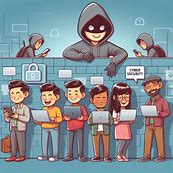The Importance of Cybersecurity: Protecting Yourself from Institutional Attacks
In today's digital age, the threat of cyber attacks is a constant concern for individuals and organizations alike. Hackers are becoming increasingly sophisticated, and their methods are constantly evolving. While it is true that hackers can target individuals, it is more likely that they are obtaining your information through institutional attacks. These attacks target organizations and exploit vulnerabilities in their systems to gain access to sensitive data.
Human Error: The Leading Cause of Institutional Attacks
Contrary to popular belief, the majority of institutional attacks are not the result of highly skilled hackers breaking into secure systems. Instead, they are often caused by human error. Even the most robust cybersecurity measures can be rendered useless if individuals within an organization are not adequately trained to recognize and respond to potential threats.
The Role of Education and Training in Cybersecurity
To combat the growing threat of institutional attacks, it is crucial for organizations to prioritize education and training in cybersecurity. This includes providing comprehensive training programs for employees at all levels, from entry-level staff to top executives. By equipping individuals with the knowledge and skills to identify and mitigate potential risks, organizations can significantly reduce the likelihood of falling victim to cyber attacks.
Best Practices for Individuals to Protect Themselves
While organizations play a vital role in safeguarding sensitive information, individuals also have a responsibility to protect themselves from cyber threats. Here are some best practices to follow:
1. Use Strong and Unique Passwords: Avoid using the same password for multiple accounts and ensure that your passwords are complex, including a combination of letters, numbers, and symbols.
2. Enable Two-Factor Authentication: Two-factor authentication adds an extra layer of security by requiring a second form of verification, such as a fingerprint or a unique code sent to your mobile device.
3. Be Cautious of Phishing Attempts: Be wary of unsolicited emails, messages, or phone calls asking for personal or financial information. Avoid clicking on suspicious links or downloading attachments from unknown sources.
4. Keep Software and Devices Updated: Regularly update your operating system, antivirus software, and other applications to ensure you have the latest security patches and protections.
5. Use a Virtual Private Network (VPN): When accessing the internet on public Wi-Fi networks, use a VPN to encrypt your connection and protect your data from potential eavesdroppers.
By following these best practices and remaining vigilant, individuals can significantly reduce their risk of falling victim to cyber attacks.
Conclusion
While hackers can indeed target individuals, the majority of attacks are the result of institutional vulnerabilities and human error. It is crucial for organizations to prioritize cybersecurity education and training to mitigate these risks. Additionally, individuals should take proactive measures to protect themselves by following best practices for online security. With a collective effort, we can create a safer digital environment for everyone.




